Installing a Twin Cam Fan Relay and Override Switch
Credit and research for this article belong to Joji Tokumoto (Grumblebuns).
The Twin Can Europa, unlike the S2, does not have a relay to operate the radiator fan. Fan operation is controlled by the Otter switch at a preset temperature of the coolant in the radiator. As such, the opening and closing of the Otter switch under fan running current will over time cause failure of the switch contacts from pitting and build up of a high resistance film reducing voltage output to the fan motor and eventually, the failure of the fan to start. The use of a relay maintains a constant voltage to the fan motor and transfers the wear and tear of switch cycling to a cheaper and more easily replaceable component.
There already is an excellent article written by Tim Engel on the Lotus Europa Central knowledge base
site on how to wire up a relay for the TC/TCS Europa:
http://lotus-europa.com/manuals/misc/electrical/manual_otter_sw.jpgMy article tries to expand Tim's write up by giving a more detailed nuts and bolts approach on wiring of my fan relay along with some pictures. This installation was done without drilling any new holes in the bodywork and the cutting or splicing of the stock wiring.
NOTE: Having a wiring diagram for your particular TC/TCS is helpful in following the description of power flow and wiring for the fan. Tim's article has two simplified drawings of the fan circuit which is also extremely helpful in keeping track of the different terminals for the circuit modification. The LEC Master Documentation has colorized wiring diagrams for all Europas.
http://lotus-europa.com/manuals/index.htm
Finding the power source
For all TC/TCS Europas, fan power flows from the ignition switch to the third fuse down on the left side of the fuse box via a yellow 12 gauge wire (pics 2,6) which is connected to one of two terminals with a spade connection. The other spade connection is for an non-fused electrical source for the power window motors. Leaving the fuse box and 35A fuse, the circuit splits off into four separate circuits via 14 gauge yellow/green wires. Two circuits are supplied by each connector, one being the OEM radiator fan supply. My Europa has a single aftermarket 10” pancake fan and thus relay and wire size selection was made for the current draw for his setup.
The first decision is determining where to tap into the wiring harness for a separate fan motor power source. The original stock wiring will only be used to supply power just for the added relay. Tim's article lays out the pros and cons of tapping into the available power sources. For my fan circuit modification, I had these criteria:
1. current flow by the radiator fan had to be read by the ammeter.
2. no splicing of existing wiring
3. no additional loading of the fuse box
4. no work behind the dash/ammeter
One way to meet all of the criteria is to tap in at the inlet of the fuse box. The solution, without splicing existing wiring is to use a “piggy back” style terminal (pic 1) along with an inline fuse for new circuit protection. This also reduces the overall current loading for the original fuse.

Mounting and wiring the relay
After the power source is determined, the next step is to select and mount the fan relay. My TCS is fitted with an aftermarket 10” pancake style fan. When running, the ammeter reads around 10 amps, with starting amps just slightly higher. For my application, I chose a 40 amp relay available at any auto parts or electrical parts store. If available, purchase a four terminal relay. You can use a five terminal relay but extra care is required to ensure that the correct output terminal (87, not 87a) is used to connect to the fan. My relay also came with a pre-wired terminal base. The advantage of the base is the ease of swapping out relays for replacement.

With one of my goals being not to drill any extra holes for this modification, I found a perfect spot to mount the relay. The cabin ventilation fan has a mounting stud connected to a bracket which attaches to the top of the radiator opening. I attached angled aluminum stock to the stud and mounted the relay to the aluminum. The relay is easy to access and is close to the fan to minimize length of wiring runs.
NOTE: There is one caveat in my wire gauge assumptions. All of my estimates of OEM wire gauge is by eyeball measuring. I have not counted the number of strands in OEM wiring harness to verify equivalent AWG size, stated wire gauge is just my estimate. My wire size by choice was 12 AWG for fan motor power and 14 AWG for relay control power.
With the relay mounted and the source of fan power determined, it was time to lay out and connect the fan motor and relay wiring. Disconnect the battery prior to starting the work.
Fan motor power connection:
1. disconnect the fan motor bullet connectors (YG and BG) from the wiring harness.
2. using a “piggy back” connector tie in the new fan motor wire to the yellow wire from the ignition switch at the third fuse (pics 1, 2 & 3).
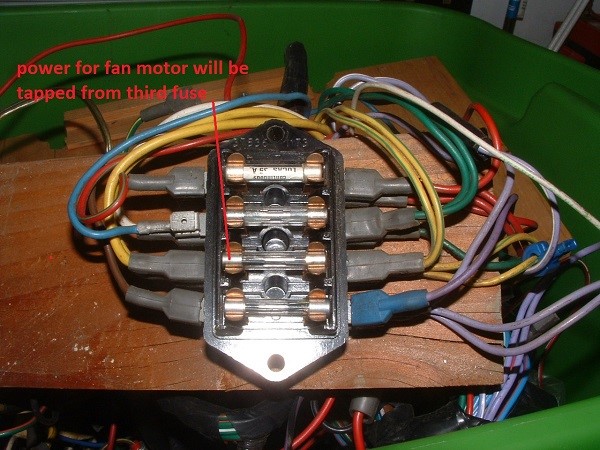
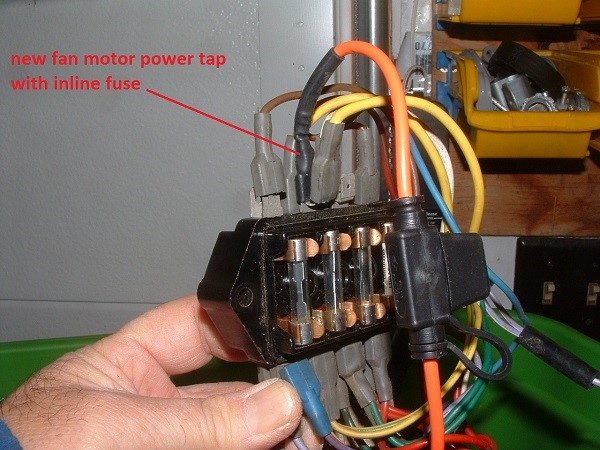
3. run the new wire along the top of the passenger side foot well and exit out the hole in the center of the front spare tire compartment (pic 4)
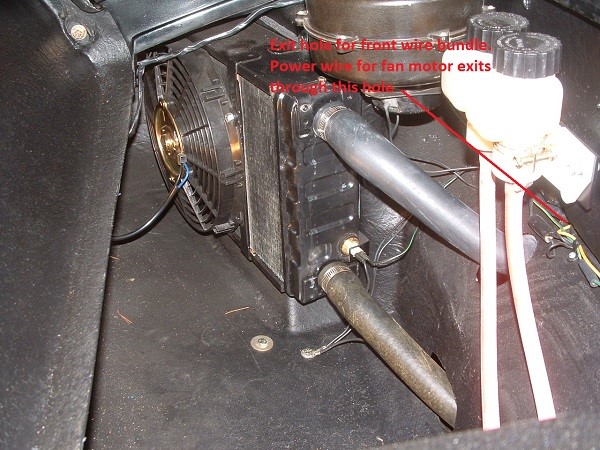
4. connect the other end to # 30 terminal of the relay
5. run a second new wire from # 87 terminal of the relay to YG lead of the stock fan motor or equivalent for aftermarket fan
6. connect a third new wire to the BG fan motor lead, or equivalent for aftermarket , and run to the common ground connection in the front plenum (pic 7)
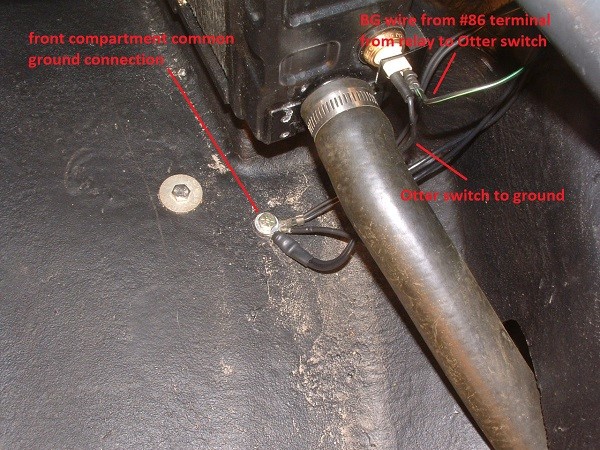
Relay control power connection:
NOTE: For relay control power, the disconnected YG and BG fan connector on the harness, will be used. With less power required for relay operation, a smaller gauge wire can be used.
1. Connect and run a new wire from terminal # 85 on the fan relay to the YG connection on the original fan harness. Use a “piggyback” connector since the wire for the override switch will tie in here.
2. Connect and run a second new wire from terminal # 86 to one of the pins on the Otter switch either pin can be used.
3. Connect and run a third new wire from the second Otter switch pin to the common ground connection point in the spare tire compartment.
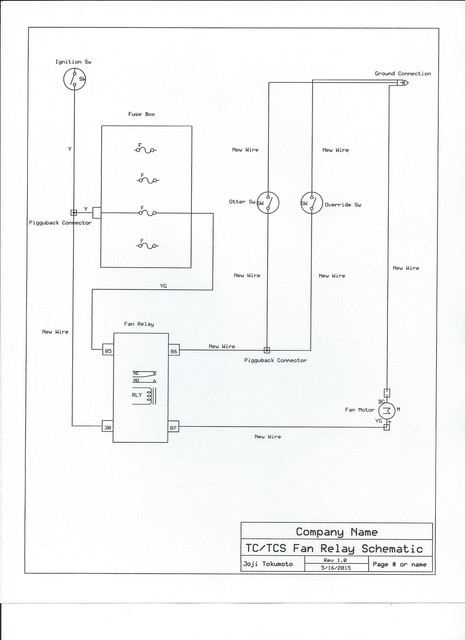
Override switch connection/installation:
NOTE: Because the Override switch operates relay power, a smaller gauge wire can also be used.
1. Connect a new wire from the “piggyback” connector on the wire going to the Otter switch and run to the drivers side foot well inside the cabin via the exit hole for the front wiring bundle.
2. Fabricate a bracket for the toggle switch. I used a 1”x1”x4” 90 deg aluminum angle stock for my bracket. Holes were drilled for the switch and the mounting hole on the handbrake bracket. The aluminum bracket was mounted between the bracket on handbrake and the angle iron connecting the handbrake to the body behind the dash.
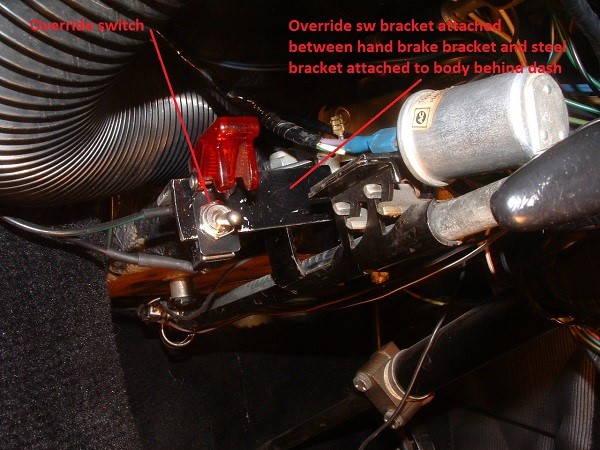
3. Connect the wire to either terminal of the Override switch.
4. Connect a second new wire to the other terminal of the Override switch and run to a good ground connection. I ran a ground wire back out to the front spare tire compartment. A more direct ground would be the bolt that secures the dash bottom to the chassis tunnel.
Testing your handiwork:
1. Double check that all crimps and/or solder terminal connections are tight.
2. Reconnect battery.
3. Flip Override switch to ON.
4. Ensure fan rotates in correct direction. If not, turn Override switch OFF and swap the leads at the fan motor. Test again.
5. Start the car and get coolant up to the set point of the Otter switch. Ensure that the fan starts.
6. If not, start troubleshooting.
Final thoughts
This article was written for the Europa owner with minimal practical wiring experience. The idea was to prevent any butchering of the stock wiring harness and be reversible if need be. The directions along with the pictures should be sufficient to allow most owners to perform this modification. For additional information on relay operation, Google “Bosch relays”. To determine the requirements for safe wire size, Google “auto wire gauge chart”. Dual fans and a higher current draw may require larger wires to be used.
Joji Tokumoto
Fallbrook, Ca